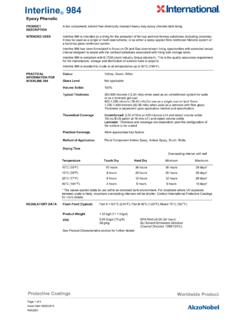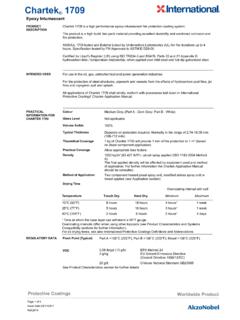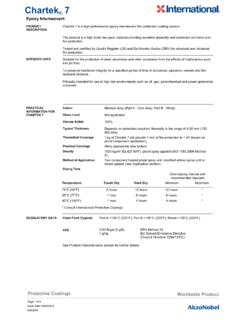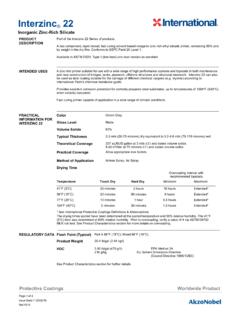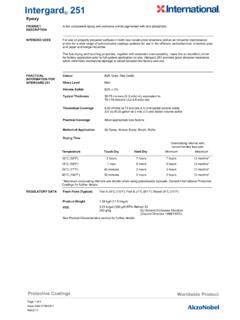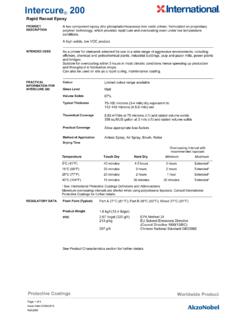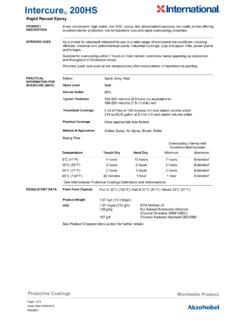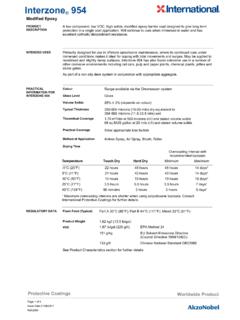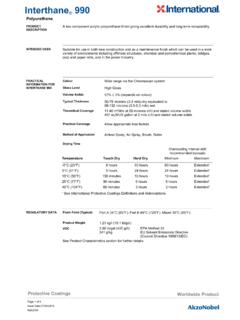Transcription of ISO12944 - AkzoNobel
1 ISO12944 Corrosion protection of steel structures by protective paint systemsWhat is ISO12944 ? ISO12944 is the industry standard for corrosion protection of steel structures by protective paint systems. Originally released in 1998, the standard is put together by representatives from key countries and companies involved in the protection of steel structures to build a mutually beneficial standard is designed to provide guidance to architects, engineers, specifiers, applicators and other parties in the application of coatings to standard covers 9 parts with key components of the standard covering environment classification, protective paint systems, laboratory test methods and systems and test methods for offshore has changed in the 2018 edition of the standard?
2 In the latest release there are a number of significant changes to the standard. These changes are:CategoryCorrosivity12944:199812944:2 018C1 Very LowHeated buildingsDry or cold with very low pollutionC2 LowLow levels of pollutionTemperate low pollutionC3 MediumUrban and industrial atmos-pheres, moderate pollution or low salinityTemperate, medium pollution, tropical low pollutionC4 HighIndustrial areas or coastal areas with moderate salinityTemperate with high pollution, tropical with moderate pollutionC5-IVery HighIndustrial, high humidity, ag-gressive atmosphereN/AC5-MVery HighCoastal and offshore areas with high salinityN/AC5 Very HighN/ATemperate and subtropical with very high pollution and/or significant chloride effectsCXExtremeN/AExtreme industrial areas, offshore areas.
3 Salt sprayIM1 Fresh waterRiver installations and hydro plantsRiver installations and hydro plantsIM2 Sea or brackish waterHarbour areas with structures and offshore structuresImmersed structures without cathodic protectionIM3 SoilBuried structuresBuried structuresIM4 Sea or brackish water with cathodic protectionN/AImmersed structures with cathodic protection1 Changes to corrosion categoriesThe old C5-I and C5-M categories have been replaced with C5 for harsh onshore categories and by CX for offshore categories. CX is taken care of in a new Part 9. There is also the addition of a fourth immersion category, IM4, which covers immersed structures in sea or brackish water which are protected by cathodic protection2 Changes to durability categoriesThe low, medium and high categories remain but they are joined by very high.
4 The durations which these categories relate to have also changed with low durability now up to 7 years and the new very high category relating to 25 years Category12944:199812944:2018 Low (L)2-5 yearsUp to 7 yearsMedium (M)5-15 years7-15 yearsHigh (H)More than 15 years15-25 yearsVery High (VH)-More than 25 yearsThe dry film thicknesses and paint systems now include minimum number of coats per coating type or technology and specify a minimum dry film thickness for the total system per corrosion category. See the coatings systems on page 5 or 6 to see which systems to specify. The standard now also includes the capacity to accept new innovative coating technologies if performance can be demonstrated by 3rd party testing and field to laboratory test methodsUp to C4 high the test methods have not changed.
5 However for C4 very high, C5 high and C5 very high, cyclic testing has been introduced to better replicate in-field conditions. CategoryLow (<7 yrs)Med (7-15 yrs)High (15-25 yrs)Very High (25+ yrs)C2 Non-cyclic Testing Durations as 1998(E) revisionISO 6270 / ISO 9227 Non-cyclic Testing:Linear Durations TBCISO 6270 / ISO 9227C3C4As C5 High. Phased cyclic testing: 10 cyclesC5 Non-cyclic Testing Durations as 1998 (E)Phased introduction of ISO 12944-9 Cyclic Testing: 10 cycles Non-cyclic Testing valid for 5 yearsImmediate introduction of Cyclic Testing: 16 Cycles ISO 12944-93 Changes to paint systemsWhy has cyclic testing been introduced?One of the major changes in the newest revision is the addition of cyclic testing for systems operating in environments of C4 very high and above.
6 AkzoNobel welcomes this addition to the standard, having found over many years that cyclic testing is more representative of real-world corrosion following charts show testing of three coating systems on long-term static salt fog testing and on a range of cyclic test methods against an in-service field trial. As can be seen from the graphs, systems performing well on salt fog testing do not show equivalent performance to those on cyclic testing or under real world conditions. For real world conditions we used our external weathering site at Blyth, UKSystem 1 System 2 System 301234 Corrosion creep of zinc-rich primed systemsUsing salt fog test (4032hrs)Corrosion creep (mm)0123 Corrosion creep comparison of zinc-rich primed systemsUsing cyclic testing methodsCorrosion creep (mm)4567 Norsok M-501 ASTM D5894 Draft NACEISO 20340 Blyth (3 Yrs)A selection of our third-party certified systemsIn conjunction with extensive in-field performance assessment, AkzoNobel commissions testing programs at third-party houses to certify systems for use in the most commonly specified environments.
7 In addition to the systems listed below we have tested a range of new and innovative products to the new revision of the standard. To gain a full listing of third-party certified systems please contact your local AkzoNobel Coat 1 Coat 2 C3 MediumIntercure 4500 @ 150 mC3 HighIntergard 251HS @ 130 mInterthane 990 @ 50 mC3 HighIntergard 251HS @ 150 mInterthane 990 @ 50 mC3 HighIntercure 4500 @ 180 m*C3 Very HighIntergard 251HS @ 190 mInterthane 990 @ 50 mC3 Very HighIntercure 4500 @ 240 m*C3 Environment Coat 1 Coat 2 Coat 3C4 MediumIntergard 251HS @ 130 mInterthane 990 @ 50 mC4 MediumIntercure 4500 @ 180 m*C4 HighInterzinc 52 @ 60 mIntergard 475HS @ 90 mInterthane 990 @ 50 mC4 HighIntergard 251HS @ 190 mInterthane 990 @ 50 mC4 Environment Coat 1 Coat 2 Coat 3C5 MediumIntergard 251HS @ 190 mInterthane 990 @ 50 mC5 HighInterzinc 52 @ 60 mIntergard 345 @ 160 mInterthane 990 @ 60 mC5
8 HighInterzinc 52 @ 50 mIntercure 4500 @ 200 m*C5 HighInterzinc 52 @ 60 mIntergard 475HS @ 140 mInterthane 990 @ 60 mC5 HighInterzinc 52 @ 50 mIntercure 4500 @ 210 m*C5 Very HighIntershield 4000 USP @ 150 mIntergard 475HS @ 150 mInterthane 990 @ 60 mC5 Very HighInterzinc 52 @ 60 mIntergard 475HS @ 200 mInterthane 990 @ 60 mC5 Very HighInterzinc 52 @ 70 mIntercure 4500 @ 250 m*C5* System tested with reduced coats as per innovative coatings technologies clausePart 9 The introduction of Part 9 to the ISO12944 standard introduces the old ISO20340 standard into ISO12944 . Part 9 mandates the use of cyclic testing for offshore structures. In previous editions of the standard offshore structures were referred to as C5-M however a new environmental category, CX, has now been introduced for all offshore offshore systems must continue to go through 4,200 hours of cycling testing, which equates to 25 9 sets both the minimum number of coats and minimum film thickness per system, with some changes from the previous standard s requirements for C5-M.
9 The table below outlines the requirements for steel CXSplash & tidal zonesIM4 Primer coatZinc (R)Other primersZinc (R)Other primersOther primersNDFT ( m) 40 60 40 60 200- 150 MNOC3333212 NDFT of system ( m) 280 350 450 450 600 800 document is not intended to be a comprehensive review of all changes to the standard, contact your local AkzoNobel representative for additional has used its best endeavors to ensure that the information contained in this publication is correct at the time of printing. Please contact your local representative if you have any questions. Unless otherwise agreed by us in writing, any contract to purchase products referred to in this brochure and any advice which we give in connection with the supply of products are subject to our standard conditions of sale.
10 Registered trademark of AkzoNobel in one or more countries. 2019 Akzo Nobel / 0920 One of the main changes in ISO12944 Part 9 from ISO20340 is in the performance criteria on corrosion creep this now states that coating systems for high impact areas shall be less than or equal to and all other CX applications less than or equal to Sea water immersion now states pass criteria and there are slight changes to adhesion as contact your local AkzoNobel representative for ISO12944 Part 9 systems.
